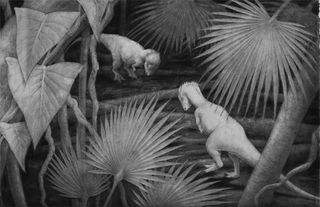Dog-Sized Dinosaur Had Thick, Head-Butting Skull

A dog-sized dinosaur may have roamed what is now Big Bend, Texas, some 70 million to 80 million years ago, ramming other paleo-beasts with a bony lump on its head.
The ancient Texan, now called Texacephale langstoni, represents a new genus of pachycephalosaur, a group of bipedal, thick-skulled dinosaurs.
Paleontologists discovered two specimens of the skull top, called a dome, from the dinosaur, in a horned dinosaur bone bed. The new species is about one of a dozen with a bony lump on its skull top, which the researchers suggest likely was used to butt heads in a manner similar to modern-day musk oxen and cape buffalo.
Darren Tanke of the Royal Tyrrell Museum in Canada spotted the first dome of the dinosaur's head while on a working holiday in January 2008.
"While I was wandering around the horned dinosaur bone bed, I happened to look down and there was this odd-shaped rock sitting on the ground," Tanke told LiveScience. "I just instinctually picked it up and when I turned it over I could see the impression of the brain case on the underside."
The dome is about the size of a peach, Tanke said.
The finding will help scientists piece together a more complete picture of species that lived in the Big Bend region, where such fossils are rare and tend to be poorly preserved, said Nicholas Longrich of Yale University, and lead author of the paper describing the dinosaur published in the April issue of the journal Cretaceous Research.
Sign up for the Live Science daily newsletter now
Get the world’s most fascinating discoveries delivered straight to your inbox.
In addition, the dinosaur seems to firm up an idea about ethnicity of sorts in dinosaurs. The discovery of the new species lends further weight to the idea, which has gained popularity in recent years, that dinosaurs found in Canada and the northern United States were distinct from their southern neighbors.
"Instead of roaming across the North American continent, we see pockets of different dinosaurs that are pretty isolated from one another," Longrich said. "Every time we get good fossils from Texas, they end up looking very different from those to the north."
The team hopes to find a complete skull of the species as well as to find more related dinosaur fossils from the Texas site.

Jeanna served as editor-in-chief of Live Science. Previously, she was an assistant editor at Scholastic's Science World magazine. Jeanna has an English degree from Salisbury University, a master's degree in biogeochemistry and environmental sciences from the University of Maryland, and a graduate science journalism degree from New York University. She has worked as a biologist in Florida, where she monitored wetlands and did field surveys for endangered species. She also received an ocean sciences journalism fellowship from Woods Hole Oceanographic Institution.
